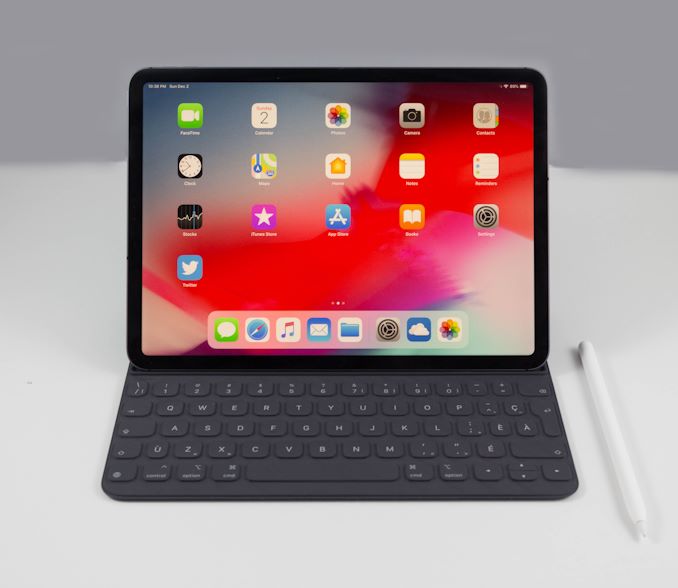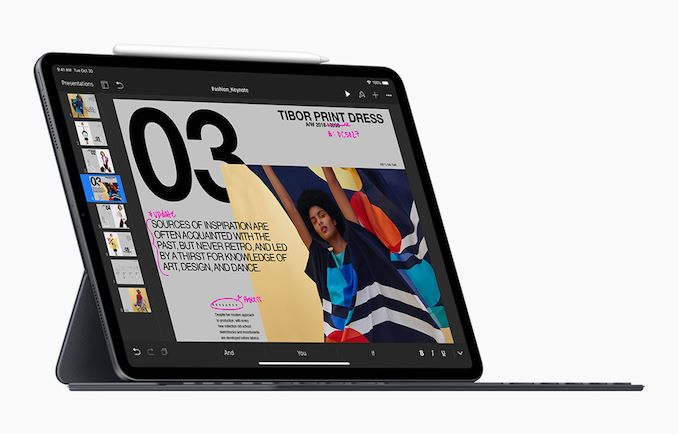The 2018 Apple iPad Pro (11-Inch) Review: Doubling Down On Performance
by Brett Howse & Andrei Frumusanu on December 4, 2018 10:00 AM EST
I think it’s safe to say that in 2018, the tablet market has not shaped up like anyone had expected, not even Apple. Tablets weren’t the next smartphone – and indeed the sales of dedicated tablets are downright soft – and yet at the same time tablets have successfully carved out a meaningful niche for themselves. But more importantly still, the tablet concept is everywhere even if “pure” tablets themselves aren’t. One needs only look at all the various PC 2-in-1s and convertibles to see the influence tablets have made on the traditional laptop market, forcing these many clamshells into becoming something more.
As a consequence of the introduction of modern tablets and their subsequent efforts to secure their own place in the market, we’ve essentially seen the tablet and tablet-alike market bifurcate into two real clusters of tablet designs. On the one hand are the cheap content consumption devices – the iPads, Fire TVs, and myriad of cheap Android tablets. On the other hand is the far more exclusive market for high-end, productivity-oriented tablets; devices that don’t just consume content, but create it as well. This market has been slower to develop, but it’s also important for its own reasons, as it’s the real crossover point between tablets as envisioned by the iPad, and the traditional PC laptop market.
Apple for their part has opted to go after both of these markets, and has done so successfully. The traditional 9.7-inch iPad needs no introduction, and while the iPad Pro is a little less known, the difference isn’t by much. Built upon the shoulders of the original iPad, the iPad Pro family takes things one step further, building towards not just a bigger and better iPad, but by giving the tablet the features that are needed for productivity and content creation, at both a hardware and a software level. The iPad Pro doesn’t try to be a traditional laptop, but it certainly tries to capture a lot of their usefulness, and this is especially the case for the 2018 iPad Pro.
With the introduction of the latest iPad Pro models, Apple’s iPad lineup for 2018 offers arguably the largest design change since the original iPad launched. The new design offers a much higher screen-to-body ratio than ever offered before, mimicking what they’ve done with the iPhone lineup. As a result, Apple has more or less reinvented the iPad Pro design, and offers plenty of new features inside and out.
Apple’s ambitions with the iPad Pro start with their chip design team, which has created the Apple A12X System on a Chip to power the latest iPad Pro. As outlined in our iPhone XS review, the A12 series of SoCs are already well ahead of the ARM competition, and Apple clearly has its sights on the performance levels of x86 CPUs from Intel. A12X features four Apple Vortex CPU cores, double that of the regular A12 in the iPhone, and seven A12 GPU cores which Apple says provides the power of an Xbox One S in a device with a far smaller power budget.
For better or worse, the iPad Pro is attached at the hip with Apple’s mobile operating system iOS, and unsurprisingly the iPad Pro ships with the latest version, iOS 12.1.
Apple’s iPad Pro lineup has also been their test bed for their newest display technology, and the iPad Pro keeps the 120 Hz ProMotion display, which offers variable refresh rate down to 24 Hz, along with P3 display gamut coverage tied in with their color managed software. Apple also keeps their True Tone option to dynamically adjust the white balance of the display to match the lighting conditions of the room it’s in.
|
Apple iPad Pro Comparison |
||
| iPad Pro 11-Inch (2018) |
iPad Pro 12.9-Inch (2018) |
|
| SoC | Apple A12X 4x Apple Vortex 4x Apple Tempest 7 core A12 GPU |
|
| Display | 11-inch 2388x1668 IPS LCD P3 D65, 120Hz |
12.9-inch 2732x2048 IPS LCD P3 D65, 120Hz |
| Dimensions | 247.6 x 178.5 x 5.9 mm 468 / 468 grams (WiFi / LTE) |
280 x 214.9 x 5.9 mm 631 / 633 grams (WiFi / LTE) |
| RAM | 4 GB (up to 512 GB Storage) 6 GB (1 TB model) |
|
| NAND | 64GB / 256GB / 512GB / 1TB | |
| Battery | 29.37 Wh | 36.71 Wh |
| Front Camera | 7MP, f/2.2, Smart HDR, Wide Color Gamut, Retina Flash | |
| Rear Camera | 12MP, f/1.8, PDAF, Smart HDR, Wide Color Gamut, True Tone Quad-LED flash |
|
| Cellular | 2G / 3G / 4G LTE (Category 16) Intel XMM 7560 Modem |
|
| SIM Size | NanoSIM | |
| Wireless | 802.11a/b/g/n/ac 2x2 MIMO, BT 5.0, GPS/GLONASS | |
| Connectivity | USB-C Apple Smart Connector |
|
| Launch OS | iOS 12.1 | |
| Launch Price | Wi-Fi: $799 (64GB) $949 (256GB) $1149 (512GB) $1549 (1TB) Wi-Fi + LTE: $949 (64GB) $1099 (256GB) $1299 (512GB) $1699 (1TB) |
Wi-Fi: $999 (64GB) $1149 (256GB) $1349 (512GB) $1749 (1TB) Wi-Fi + LTE: $1149 (64GB) $1299 (256GB) $1499 (512GB) $1899 (1TB) |
Apple has also taken the opportunity to switch the iPad Pro lineup over from their proprietary Lighting connector to the more ubiquitous USB-C port, making this the first iOS device to offer USB connectivity. Where they give, they also take away though, and the 3.5 mm headset jack has gone the way of the Dodo, and for more or less the same reasons.
For those that want to work on the go, Apple continues its excellent tradition of offering cellular connectivity with the iPad Pro, and those that need a lot of storage will be happy to see models up to 1 TB, which is more important because the iPad offers no way to access external storage to increase this.
What first set the iPad Pro apart from the rest of the iPad lineup was the ability to use the Apple Pencil as well as a first-party keyboard solution. For the 2018 iPad Pro, both of these accessories have gotten refreshes as well.
The iPad Pro for 2018 is a major change from the outgoing models. Let’s dig in and see how it fares.











145 Comments
View All Comments
Ryan Smith - Tuesday, December 4, 2018 - link
Unfortunately we don't have that one. These go back to Apple when we're done.MonkeyPaw - Tuesday, December 4, 2018 - link
I have the 2017 12.9” 64GB model, though I’m not on staff and don’t have your benchmarking suite.MonkeyPaw - Wednesday, December 5, 2018 - link
Not sure how this will for,at on this comment system, but here is what I got on my 2017 iPad Pro 64GB;TabletMark 2017
Overall: 1404
Web-Email: 1438
Photos-Video: 1372
Speedometer 2.0: 89.0
WebXPRT 3.0: 131
Kraken 1.1: 856ms
Slingshot 3.1 Extreme:
Graphics: 6,514
Physics: 2,602
Ice Storm Unlimited
Base: 55,609
Graphics: 118,335
Physics: 19,482
GFXbench Aztec Offscreen
High: 21.5
Normal: 59.3
melgross - Tuesday, December 4, 2018 - link
They supply a 1 meter USB C cable because the usb 3.1 gen 2 spec for data transfer is 10Gbs for 1 meter, but 5Gbs for anything longer to about 3 meters, where it then peters off to about 3G s to about 4 meters.I imagine they’re concerned that people will complain that they’re not getting the 10Gbs speeds, and blame Apple and the iPad for that if they give a longer cable. Apple has difficulty communicating these problems for some reason. They should just state the data transfer speeds with different cable lengths so that people understand what they’re doing. I have a few USB 3 to USB C charging cables, and none are usb 3 anything. They’re all usb 2 cables with a 480Mbs transfer rate. Most people don’t understand the totally screwed up spec that usb is.
tipoo - Tuesday, December 4, 2018 - link
They only use USB 3.0 anyways, so not that.melgross - Tuesday, December 4, 2018 - link
What? It’s 3.1 gen 2. Just go to their site and read the speed spec for yourself..tipoo - Monday, December 10, 2018 - link
I don't see 3.1 gen 2 anywhere on their specs sheethttps://www.apple.com/ca/ipad-pro/specs/
Last news I heard was the iPad Pros were the first to move to 3.0 while the phones were still on 2.0, I don't see anything corroborating 3.1 gen 2 on a quick google for the new ones.
https://www.cultofmac.com/397412/ipad-pros-sneaky-...
gailthesnail - Thursday, December 20, 2018 - link
The iPad pro's USB 3.0 functionality is heavily restricted and is only enabled for the lightning to SD card dongle. Anything else like connecting to iTunes to transfer media is limited to USB 2.0 speeds. This is what I've experienced so far on my 2017 iPad pro 10.5. I'm not 100% sure but I think it's the same for the new iPad pros as welltipoo - Tuesday, December 4, 2018 - link
I hope iOS13 does remove most of the hurdles with working off iOS. The power is clearly there, if you chart out Apple device performance per dollar the 11 inch Pro is way ahead of the Macbooks, but you just can't do as much on it.Something as simple as working off of media off an external hard drive which you take for granted on any traditional OS you just can't do here. External hard drives aren't natively supported at all. Then there's lack of a trackpad and a cursor for fine text selection, Xcode, etc etc.
All this power seems like it was meant for an OS that was pushed back in favor of polish, and hopefully 13 really unleashes it.
HStewart - Tuesday, December 4, 2018 - link
IOS and Mac OS ( or Windows ) are different OS - iOS is app centric OS while Mac OS and Windows is desktop centric OS. Apple is unfortunately in delusion that iOS and iPad Pro can replace the desktop / laptop devices.Even with Photoshop Creative Cloud on it - it nothing like the Photoshop CS5 ( which I owner ) and in my opinion it just and over larger iPhone.